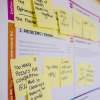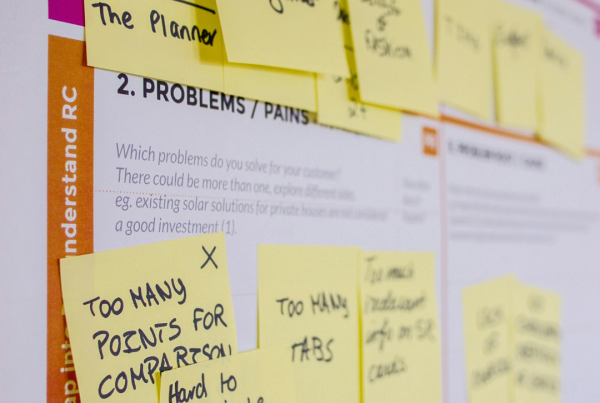The product planning process can often be lengthy, filled with meetings after meetings while trying to get every stakeholder to agree on a direction or strategy. However, in my consulting experience, there is a faster way to get alignment: through a design sprint.
Design sprints aren’t just for product design and innovation; they are also powerful tools for strategic planning. A sprint doesn’t necessarily have to focus on building a prototype or redesigning a product. You can tailor it to help you achieve other product milestones such as a high-level product vision, product strategy, product roadmap, and foundational UX/UI journey.
Anchored in design thinking principles, a design sprint can help solve any business problem you have. Due to its structured, time-based, and collaborative approach, you’ll be able to accomplish more in a shorter time frame.
A design sprint also comes with the added advantage of achieving alignment from relevant stakeholders in as little as a week. However, the downside is that you will need to find 4-5 days where everybody is available to participate in a sprint, which can be cumbersome to schedule. Still, it’s better than being bogged down by lengthy and unproductive meetings week after week.
Before I begin, read my previous article on design sprint overview. Now, let’s jump into it and I’ll show you how you can tailor a design sprint to create compelling product vision, realistic strategies, and actionable roadmaps as the foundation for a user-centric product.
How to Run a Design Sprint for Strategic Product Planning
When it comes to product planning, a sprint helps you gain clarity. It helps you in figuring out investment and resourcing priorities, determining key product areas to focus on, and effectively planning your product design and development.
Some of my clients have approached me with an idea for their product or project, but often without a clear direction or product strategy. My design sprints help them establish a clear direction, set clear goals, and develop an actionable plan for it in order to establish a solid foundation they can work on.
These are planning objectives you can run a design sprint for:
- Determining your product vision, purpose, competitive edge, and target market
- Validating your product idea or idea for improvements
- Figuring out product priorities and developing a product roadmap
- Planning for product design, development, and launch
- Deciding how to effectively use your resources and budget
- Optimising your product process and workflows
- Aligning teams and getting buy-in from all stakeholders involved
Every client has different challenges and needs, so I usually design the sprints to produce what the organisation or startup needs.
The typical output or result you can expect from a product planning sprint could be a:
- High-level product strategy
- High-level product roadmap
- High level end-to-end product plan
- Storyboard or UX flow for the product’s key functionalities
- Product prototype
As for the sprint itself, each day may look slightly different from a typical design sprint. It would still be a four-to-five-day process, but each day would be designed differently to achieve the sprint’s result. Below is a rough outline of a planning design sprint.
Pre-sprint: You will be defining the challenge, gathering existing data, and getting everyone up to speed with the current challenge or aspirations.
Day 1: This day will be about mapping the challenge, getting opinions from subject matter experts, and determining the sprint goals or success metrics.
Day 2: The second day is the time to deliberate over the challenge and come up with a variety of solutions as individuals. There are a few ideation techniques I use such as lightning demos, mind mapping, and sketching activities.
Day 3: This is the time for individual ideas to merge to form the best idea. When doing strategic planning, you will start to see the rough outline of the product’s direction, unique selling points, the roadmap, the user journey, or what the key features of the product will look like. It’s also a day to obtain a general consensus where all stakeholders are aligned.
Day 4: Depending on the sprint’s objectives, you’ll either be working on a prototype, UX flow mock-up, storyboard, or roadmap. You also need to consider the different scenarios that could happen to ensure your strategy is robust.
Day 5: The final day is for testing or presenting the idea, gathering feedback, and deciding on the next steps.
Post-sprint: You’ll need to develop actionable plans and share the strategic plan with relevant parties. Crucially, there needs to be regular reviews to measure the progress against the product strategic plan, so you can make adjustments when something isn’t working out.
Tips for Strategic Product Planning Design Sprints
One big tip to make your planning sprint a success is to avoid thinking about the final product too much. Remember, you’re working on the high-level product direction, vision, selling points, priorities, UX flow, or roadmap, not the product. Your strategic plan is about the big picture, not the nitty gritty UX and UI details, which are for subsequent sprints.
Finally, a design sprint can be tailored to what you want to achieve out of it. Using a sprint’s structure, you can adjust each session or day to host discussion activities that are unique to your organisation, but are still time-bound and focused on producing results quickly.
This is where having an experienced design sprint facilitator makes a big difference – one who can keep the sessions focused, maintain momentum, and get the most out of the group. Design sprints can be extremely powerful, if you do it right.







